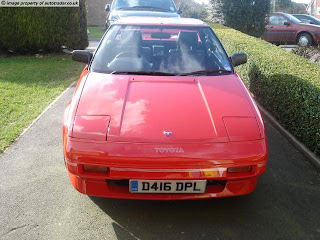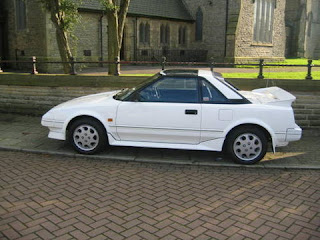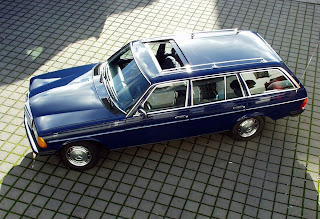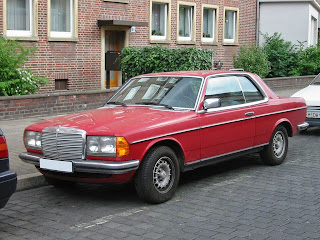Wait, I haven't finished... There's DETAILED SPECIFICATIONS and LASTLY a WHOOPING 20 Owner's Review from ALL OVER THE WORLD by carsurvey.org. So sit back, relax, and enjoy the review.
In Malaysia, I found 3 units on sale. A 1985 Track car going for RM12k, the other 2 price not listed. The MR2 MK1/MK1.5 is so RARE (less than 120 units on the road) today that it's BUYER'S MARKET. Ie. Buyer Determined the price.
Let's Proceed to VIDEOS:
Wheeler's Dealers Part 1: Toyota MR2 MK1 1.6 -NA-
Wheeler's Dealers Part 2: Toyota MR2 MK1
Wheeler's Dealers, Part 3:
Wheeler's Dealers Part 4:
Wheeler's Dealers Part 5:
Wheeler's Dealers Part 6:
Top Gear (UK) Old vs New (Toyota MR2 MK1 vs MR-S MK3)
History of the Toyota MR2 Mk1
(SOurce: http://www.mr2mk1club.com/_newsite/index.php?currPage=mr2mk1)

1976 - The project that would eventually become known as the "MR2" was conceived. However, the actual project did not get off the ground until 1979 when the design process got underway. Whilst the car is recognisable even from the first design the car would go through many changes before the prototype, labelled the SA-X, was built. This was an extraordinarily exciting piece of work for the staff at Toyota, with some employees giving up their summer vacations to test the car.
1976 - The project was re-evaluated by Toyota Management and the first prototype SA-X was built. The car was designed by Seiichi Yamauchi. The inspiration for his design was the "Katana" a Japanese sword.
1983 - Final design changes were made and the car was re-labeled the SV-3. The SV-3 made its debut at the Tokyo Motor Show and caused notable excitement as it was the first lightweight mid-engine sports car to be built in Japan.
1984 - The SV3 received some body changes and the concept car was given an internal production code, from now on, internally at Toyota the MR2 would be known as the "AW11" a nickname that stays with the car to this day. The press and public were informed that "MR2" stood for Midship Runabout, 2 Seater, but it also made reference to the cars Mid-Engine, Rear Wheel Drive configuration.
1984 - The MR2 is launched in Japan and the car wins the Japanese "Car of the Year" award for 1984. The AW11 MR2 was launched with a 1587cc, 16 valve, DOHC engine dubbed the 4A-GE. The engine was equipped with Denso electronic multi-point fuel injection system and a variable intake system called T-VIS. The Japanese Domestic Market (JDM) had the option on an AW10 which was equipped with the 1452cc 3A-U engine. It is believed less than 2000 of these models were built and there are no known models of the AW10 in the UK.
1986 - In 1986 the MR2 went through several changes to improve looks, handling and performance. Toyota introduced a "T-Bar" version with leather interior (not in Japan). This was not available in the UK until 1987 however and leather interior was made standard on T-Bar models in 1988 for the UK. Many minor changes took place (see Mk1a to Mk1b differences article for full details) Cosmetic changes that happened were colour-coding bumpers and skirts and a new design of alloy wheels. A key none cosmetic change was the change from C-50 to C-52 gearbox as some of the early Mk1a's had developed a problem with 5th gear. The new revision of the MR2, which has now become known as the "Mk1b" also received uprated brakes, improved suspension and a stronger engine block.
1987 - The Supercharger. In 1987 Toyota introduced the 4A-GZE engine to the MR2. Based on the same block and head as the 4A-GE, the 4A-GZE was equipped with a SC-12 roots type Supercharger and a Denso top-mounted Intercooler. This version of the MR2 was only sold on the Japanese Domestic Market (JDM) and US Domestic Market (USDM). All Supercharger's in the UK are either conversions or JDM Imports.
1989 - In 1989 there was a limited production run of the MR2 called the "Super Edition", this was a JDM Only model that was done in Midnight Blue (8E4) with Recaro Interior and Mirror Polished Alloys. The "Super Edition" was also produced in White over Gold with Recaro Interior and Mirror Polished Alloys. 270 were produced of both versions.
1990 - Production of the AW11 MR2 ceased with a total of 165,000 being produced and distributed across the world. 32,000 of which ended up in the UK.
TOYOTA MR2 MK1 Buyers Guide 1: (Link)
http://www.mr2mk1club.com/_newsite/index.php?currPage=mr2mk1&currPageSub=buyersguide
MR2 MK1 Buyer's Guide 2: (Link)
http://www.challoner.com/mr2/tech/mk1bg.html
TOYOTA MR2: MK1a - MK1b Differences
Source:
http://www.mr2mk1club.com/_newsite/index.php?currPage=mr2mk1&currPageSub=differences
Aesthetic & technical updates to the Toyota MR2 Mk1...
TOYOTA MR2 MK1 EXTERIOR
* Front bumper is 1” narrower on Mk1a than Mk1b
* The very early Mk1a front bumper is flat at the front & painted matt black as standard
* Front bumper bar iron on Mk1a is different than Mk1b. (but interchangeable only if you fit the same bumper skin and foam insert)
* Mk1a does not have central locking from the door key, Mk1b does
* Mk1a has smooth wing mirror housings, Mk1b has textured effect
* Mk1a had black moulded door & panel protector strips, Mk1b have colour coded clear plastic strips
* Mk1a cars had front mud flaps as well as rear flaps, MK1b only had rear flaps
* Very early Mk1a had black unpainted plastic rear sill protectors
* Very early Mk1a had black caps on wheel nuts
* Mk1a has metal (some plastic) lower front spoiler, mk1b is plastic. Also MK1a has different front panels
* Mk1a had “triangle” alloys, Mk1b has “teardrop” alloys. MK1a 5.5J & MK1b 6J, so MK1b alloys are slightly wider
* Mk1a engine cooling grille is metal & was split into two sections, MK1b was plastic & single entry type which protruded further outwards from the body
* Mk1a had roof mounted manual aerial, MK1b had electric aerial mounted on the rear o/s wing
* Mk1a only had sunroof & tintop options, Mk1b had T-bar, Sunroof & tintop options
* Very early Mk1a sunroofs have no dot pattern in the blackout paint. MK1b’s do
TOYOTA MR2 MK1 INTERIOR
* Mk1a had two tone seats, Mk1b are single coloured
* Mk1a interiors (excluding seats, headlinings & sunroof cover) were all black
* Mk1a original radio very basic compared to Mk1b
* Inner door handle backing plates on Mk1a different thickness to Mk1b & not interchangable between the two
* Mk1a wiper / headlight switches are more square than the Mk1b's rounded type
* Mk1a has no glove box key lock, Mk1b does
* Mk1a headlights don’t rise on the first switch position, they don’t have dim/dip, so its side lights only. Mk1b lights do rise on the first position & operate in dim / dip mode with side lights
* Mk1a has sub woofer under driver’s seat, Mk1b doesnt have this
* Between seat cubby box has lid support on Mk1b only, not on Mk1a
* Mk1a had only one behind the seat coat hook, Mk1b had two
* Mk1a inner door cards are different than on Mk1b, switches sit in a semi-circular pod, although the switches are interchangeable
* The air vents at either end of the dash on a Mk1a have silver center knobs, Mk1b had black only
* Radio surround on Mk1a is different to Mk1b & incorporated a small light
* Centre arm rest on a Mk1a incorporates a padded arm rest, Mk1b doesn’t
* On a Mk1a the ashtray is located forward of the gearstick, on a Mk1b its to the side of the centre console
* Heater controls on a Mk1a are basic design with levers & knobs for air flow etc, on a Mk1b they are push buttons with green L.E.D’s & motorised direction flaps
* The Mk1a heater control panel incorporates the cigarette lighter, on a MK1b this is housed under the ashtray flap & the cigarette elements are not interchangeable
* Lights up warning buzzer found on Mk1b only & only on ‘F’ & ‘G’ reg
* Dash speedo lights on Mk1b 'F' & 'G' reg ONLY had dimmer switch fitted
* Mk1a boot trim is different shape to Mk1b & not interchangeable
* Mk1a boot has fibre board covers over the inner wing area behind the o/s/ & n/s boot panels
* Mk1a coolant filling procedure warning sticker on the engine lid is yellow, on a Mk1b its blue & white
* Tyre pressure information sticker on the bottom of the drivers door on a Mk1a is different to Mk1b
* Mk1a dash gauges have larger increments than Mk1b
* Mk1a had no rear speakers, Mk1b did
* Mk1a steering wheels had exposed metal supports, Mk1b’s were covered
* Mk1a steering wheel 2.5" larger than Mk1b
* Mk1a had black front strut top caps, Mk1b’s didn’t
* Mk1b T-tops ONLY had front strut brace fitted as standard
TOYOTA MR2 MK1 - MECHANICAL
* ECU is NOT interchangeable from Mk1a to Mk1b
* Mk1a ECU is more aggressive for fueling than Mk1b
* Mk1a weighs less than Mk1b
* Mk1a has different radiator brackets to Mk1b
* Mk1a has two mounting bolts on the brake master cylinder, Mk1b has three bolts
* Air filter on a Mk1a is in the engine bay, on a Mk1b its in the boot behind the n/s boot panel
* Mk1a drop links are different length to Mk1b
* Brake disc’s are smaller on a Mk1a than Mk1b
* Cam covers have “16 VALVE” in blue on a Mk1a, on a Mk1b this is in red
* MAP sensor on a Mk1a is square, on a Mk1b this is rectangular & NOT interchangeable between the two models
* Rear suspension subframe is different between a Mk1a & Mk1b
* Mk1a have single jet injectors, Mk1b have twin jet, higher flowing injectors & are interchanglable providing the engine bay loom is changed between the two models
* Mk1a TVIS comes in at a lower RPM than Mk1b
* The air intake temp sensor on a Mk1a is on the TVIS manifold (after throttle body), on a Mk1b its on the intake pipe (before throttle body)
* Mk1a have a VTV dashpot under the throttle body acting on the throttle stop, Mk1b’s don’t have this
* Mk1a has smaller clutch (200mm) Mk1b has larger clutch (212mm)
* Mk1a has smaller diameter rear anti roll bar than the Mk1b
* Mk1a has C50 gearbox, Mk1b has C52 gearbox
* Rear track rod control joints are different on a Mk1a than Mk1b
* Struts are different on Mk1a than Mk1b & are not interchangeable without cutting studs & drilling holes
* Mk1a and Mk1b drive shafts are different, having different ends at the hub and not interchangeable
TOYOTA MR2 MK1 - WHEELS AND TYRES
* Standard Wheels
* Rim size: 14"
* PCD: 4x100
* Offset: 35 -> 38
* Centre bore: 54.1
* Standard tyres: 185/60/14
* Standard Tyre pressures: Cold Tyre Inflation Pressure = 1.8 / 26 FRONT 2.0 / 28 REAR
* Mk1a had ‘triangle’ alloys as standard, while the Mk1b had ‘pepperpot’ alloys as standard
* Larger Wheels that will fit on a MR2 MK1: Alloys up to 17" have been fitted, but all changes will affect handling
* Larger alloys must have the offset within the standard alloy range in order to fit
* Spacers can be used to help achieve correct offset
CAMBER/CASTOR SETUP:
TRD setup:
Toe-In:
ft=1.6mm (stock=1mm)
rr=3.2mm (stock=4-5mm)
Castor = 6 deg (don't worry about this too much though )
Camber:
ft= 1mm neg (stock zero)
rr= 1.5 neg (stock 1 deg)
TOYOTA MR2 MK1/MK1.5 Paint codes/Colour Choices:
* Beige Metallic (4G8)
* Black Metallic (204)
* Black (202)
* Dark Blue Pearl (8E3)
* Grey Metallic (167)
* Ice Blue Pearl (8G2)
* Dark Jade Metallic (6H7)
* Light Beige Metallic (4E3)
* Light Blue Metallic (8B8)
* Medium Red Pearl (3H4)
* Orange Pearl (3H5)
* Silver Metallic (166)

* Super Red (3E5)
* Super Silver Metallic (150)
* Super White (040)

* White (043)
* Dark Jade/Light Beige (2S8)
* Jade/Beige (28B)
* Grey/Super Silver (21E)
DETAILED SPECIFICATIONS:
Body: 2 Seater, Coupe OR T-bar glass roof.
Cd: 0.34
Dimensions and Weights:
Curb weight ........................... 1181 kg (2600 lb)
Weight distribution (%) ............... 44/56
Wheelbase ............................. 2320 mm (91.3 in)
Overall length ........................ 3925 mm (154.5 in)
Overall width ......................... 1665 mm (65.5 in)
Overall height ........................ 1250 mm (49.2 in)
Track ................................. 1440/1445 mm (56.7/56.9 in)
Min. ground clearance ................. 127 mm (5.0 in)
FUEL INFORMATION:
Fuel capacity 40.9 litres
Average comsumption: 7.3 l/100km, kms: 13.7km/L (31mpg)
ENGINE:
Bore × stroke 81.00 mm × 77.00 mm
3.19 in × 3.03 in
Cylinders In-line-4
Displacement 1.6 litre
1587 cc
Type DOHC, 4 valves per cylinder
16 valves in total
Compression ratio 10.00:1
Fuel system TCCS fuel inj.
Maximum power
(DIN) 123.7 PS (122 bhp) (91 kW) @ 6600 rpm
Specific output 76.9 bhp/litre
1.26 bhp/cu in
Maximum torque
(DIN) 142.0 Nm (105 ft·lb) (14.5 kgm) @ 5000 rpm
bmep 1124.4 kPa (163.1 psi)
Specific torque 89.48 Nm/litre
PERFORMANCE:
0-60 mph (96km/h) 7.9 s (0-100 km/h 8.5 s)
0-100 mph 25.00 s
80-120 km/h (50-70 mph) in top
Standing ¼mile 16.50 s
Power-to-weight 125.13 bhp/ton
Standing km 30.40 s
Top speed 197 km/h (122 mph) (JDM limited to 180km/h/116mph)
OTHERS:
Lateral acceleration .................. 0.84 g
Interior Sound Level:
Idle .................................. 51 dBA
Full-throttle acceleration ............ 86 dBA
70-mph cruising ....................... 78 dBA
70-mph coasting ....................... 75 dBA
CHASSIS:
Engine location Mid
Engine alignment Longitudinal
Drive RWD
Steering rack & pinion
Ratio ................................. 18.0:1
Turns, lock to lock ................... 3.1
Suspension
front Independent, MacPherson Struts, Coil Springs, ARB.
rear Independent, Chapman struts, trailing-arms, coil springs ARB.
.
Brakes: F/R Ventilated Discs/Discs, Servo-Assisted
Transmission
5 speed manual
Gear Ratios:
Transmission rations:
1st ................................. 3.17
2nd ................................. 1.90
3rd ................................. 1.31
4th ................................. 0.97
5th ................................. 0.82
Axle ratio ............................ 4.30
Final drive ratio ..................... 3:53
END OF SPECIFICATIONS.
Let's proceed to owners' review:
Visit: SOURCE: http://www.carsurvey.org/reviews/toyota/mr2/










Overall marks (average of all marks) 9.0 / 10


The T bar is nice on sunny days, as it can be removed so you can appreciate open top driving.
The car is also good on fuel due to its light weight and small engine, average 30-35 mpg.
SOURCE: http://www.carsurvey.org/reviews/toyota/mr2/
REFERENCES:
1) Most pictures taken from Autotrader.co.uk/
2) www.youtube.com (search Toyota MR2 MK1)
That's all folks, thanks for having time and patience to read this blog entry.


















































